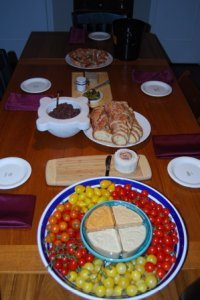Hosting a Wine Dinner Party

One option for having a wine tasting is to host a wine dinner party. While an evening of just wine or wine with finger food accompaniments can be lots of fun and give you the opportunity to sample several different wines, there is nothing quite as hedonistically satisfying as having a wonderful meal paired with great wines that accompany the food. After all, most wine is meant to be drunk with food and some of the most epiphanic sensory experiences are a perfect pairing of a dish with the right wine. Therefore, when we get tired of non-stop wine, we like to settle down with some good friends over some delicious food paired with great wine at a wine dinner party.
There are many ways to plan and host a wine dinner, from a family style feast with an assortment of wines to a fancy gourmet style presentation with individual meal courses paired with specific wines. Either way can be a lot of fun and very satisfying, it just depends on what you would like your evening to be like and how much energy you want to exert in the planning and preparation. Here we will give you a few ideas, tips and pointers to help your next wine dinner party be a smash success.
Family-Style Dinner PartiesThis is probably the easiest and least time consuming way to host a dinner party. Rather than individual courses, all the food is served at around the same time on big platters that are passed at table. It is nice to have an appetizer or two (olives, cheese, etc.) available beforehand for guests to munch on before sitting down to dinner while enjoying an
apéritif drink. This takes the worry out of individually plating dishes for each guest and it also allows you to cook foods which are not quite as delicate and complicated. Hearty foods like pastas, stews, rice dishes, and roasts are great served this way accompanied by a few plates of sides like beans, corn, mixed vegetables, rice, etc. This lets your guests just dig in and choose what they want. The nice thing about this style of wine dinner party is that you can easily have guests bring a dish to throw into the mix if you want to make it more of a potluck to take all the cooking pressure off yourself. In fact, the entire thing could be a potluck...have each guest bring a dish and a bottle of wine to go with it. This usually leads to an interesting mix of foods and wines which may surprise you. We'd advise telling guests the general type of food you'd like them to bring so it fits the theme, if there is one, and so that multiple guests don't bring the same thing!
With a family-style dinner party, besides being easier, it also takes the focus off any single wine pairing with one particular food. Guests can feel free to sample several different foods with several different wines and make their own decisions about what goes best and what doesn't work.
Multi-Course Food and Wine Pairing Dinners
The height of elegant dining is a multi-course meal of beautifully presented food. If food and wine pairing as well, you can have an individual wine served with each course. If you want, for your dinner party you can supply all the wine and food or you could prepare the food and ask your guests to bring a bottle of wine each and give them tips on what types of wines you'd like to accompany the courses of the meal. This leads to an elegant, slow dinner which allows you and your guests to focus on each dish and to focus on each food and wine pairing, rather than a messy free-for-all. While the family-style dinner can lead to joyous frivolity and loud conversation, a presented multi-course meal is generally slow and more under control. This allows more time and focus to be put on the individual courses and wines.
If you are worried about how to prepare so many courses for guests at your dinner party, there are a few tips we can give you. First of all, take a breather. It is ok if there is a lag between courses while you prepare or plate the next one. No one expects you to have 20 assistants and servers like in a fancy restaurant. Everyone is there to relax and have fun. Second, try to plan foods that you can prepare at least part way ahead of time. Slow cooked roasts, stews and soups are great because they take a long time to cook and you can just let them go earlier in the day (or even the day before in the case of some stews and soups) and just reheat them briefly before serving. Get as much done the day before or that morning as possible so that when your guests arrive you aren't in the kitchen non-stop. Finally, remember that each course does not need to be a complicated piece of art. Start simple with a soup (pre-made) and then a salad course. Thats two courses right there! Then move on to a roasted poultry with vegetables dish and then on to a meat if you'd like. Try to focus most of your energy and time on one or two main courses which will really be the centerpiece to the evening, not on trying to produce seven or eight masterpieces. First of all, too many complicated courses can overwhelm your guests. Second, remember, you are not a restaurant. If you don't have sous chefs and platers and servers working for you (although your spouse or significant other may act like one for the night) like a professional chef, then don't try to over-extend yourself.
Pay Attention to the Progression
In planning a food and wine dinner party, be sure to pay attention to the progression of food and wine through the night. You have probably noticed that multi-course meals follow somewhat of a predetermined progression. In general, foods go from lighter and simpler to heavier and more complex and finally to the sweet dessert. Wines should follow a progression as well. If you pair well with the foods, then they will naturally follow this progression. But in general we start with lighter white wines or sparkling wines, move to more full bodied whites, on to lighter red wines, to fuller bodied reds and finally end with a sweet dessert wine (if you are serving one). Finally, to end, coffee or even an after-dinner drink, or digestif (such as brandy or cognac), is often served. This progression in food and wine is designed to avoid overwhelming the dinner's palate. By starting light and simple and building up, nothing clashes with what came before it or after it, it is a gentle crescendo-decrescendo throughout the meal. You will find a few exceptions to the rule, such as serving Sauternes (or other sweet white wine) with the foie gras course which often comes earlier in the menu.
Classic Pairings Versus Trying Something New
There are many classic pairings in the food and wine world that you can use in preparing a wine dinner party. For example, Bandol with boulliabaisse, Chateauneuf-du-Pape with roast leg of lamb with garlic and Provençal herbs, Port and Stilton cheese, Sauternes with foie gras and Cabernet Sauvignon with grilled steak. These and many others have been tested and confirmed millions of times over across centuries. They rarely disappoint. When first learning about matching food and wine it can be very useful to try these classic pairings to get a sense for what wine and food can do for each other. However, as you get more experience, you may want to branch out. Or you may have foods you aren't quite sure what to match with. It is perfectly acceptable to try new pairings that you haven't heard of before or that even go against the classic teachings of food and wine pairing. If you find a new combination that works magically, then great! If it doesn't work, then you have learned something and you can try to figure out why didn't it work. Were the flavors in the beef stew too bold for the floral Viognier you served? Did the big body and tannin of your California Cabernet overwhelm the braised fish fillets? Or was there just a flavor in that Sauvignon Blanc that classed with the herbs in your vegetable soup? Pay attention not just to what works but what doesn't work so that you gain a better understanding for future pairings.
Plan The Meal, Let Your Guests Pair the Wines
As mentioned above, one way to get your guests involved and to take some of the work and expense off yourself is to get them to do the work of pairing wines. If you like to cook, plan the meal ahead of time and give one course to each guest to bring a wine they think will work with it. They can do the legwork of investigating what would go best with their assigned course. You may be surprised by what some guests bring and they could either be a disaster or a huge surprise and success! Alternatively, if you don't like to cook or feel overwhelmed by cooking for so many people, do the opposite. You plan the wines and have each guest bring a dish to accompany them.
Print a Menu
One trick that we have found to turn any dinner party into an even better dinner party is to print out menus beforehand which are placed at each guest's seat. When we say menu, we mean it in the French sense, not a list of things for them to order from, but rather a list of the foods to be served and in what order. You can easily prepare this with fancy fonts on your word processing program and print them out. Include the appetizers and apéritif and progress through the first courses, main entrees, cheese course and dessert. Even if you serving family-style, you can list all the things that will be served. If you are pairing wines, then list the wine beneath each course. If not, then list the wines (if you know them ahead of time) at the bottom. At the top list the date and occasion to make it feel important. A menu makes the event seem like more of an event. It adds romance and excitement. For a little more dramatic presentation, as long as your guests won't think it pretentious, list each course in English as well as French (or Spanish or Italian, depending on the cuisine you are serving). Or use French words for some things. I know, sounds snobby, but it adds to the air of culinary excellence and excitement!
Good luck planning your wine dinner party!
Done learning about How to Host a Wine Dinner Party?
Return to the Food and Wine Pairing page.









